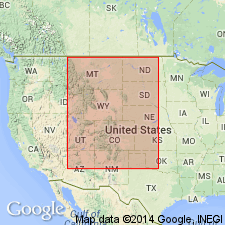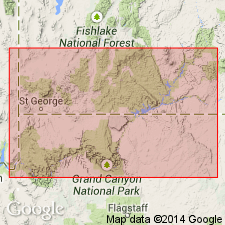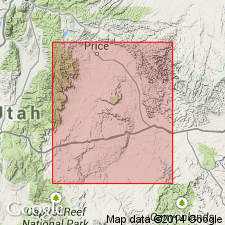
- Usage in publication:
-
- Page Sandstone*
- Modifications:
-
- Areal extent
- AAPG geologic province:
-
- Paradox basin
- Uinta basin
- Uinta uplift
- Green River basin
Summary:
Known to extend from northeast AZ across central UT to southern part of eastern Uinta and western Sweetwater Cos., southwest WY, or into the Paradox, Uinta, and Greater Green River basins, and the Uinta uplift. Age assignment of Middle Jurassic retained.
Source: GNU records (USGS DDS-6; Denver GNULEX).

- Usage in publication:
-
- Page Sandstone*
- Modifications:
-
- Named
- Dominant lithology:
-
- Sandstone
- AAPG geologic province:
-
- Plateau sedimentary province
- Paradox basin
Summary:
Named for town of Page, Coconino Co, AZ in the Plateau sedimentary province. Type section measured on northwest side of Manson Mesa in SW1/4 NW1/4 sec 19, T14N, R9E. Formerly an unnamed part of Navajo Sandstone. At type Page is 55.8 m thick. Lies unconformably (J-2 unconformity) above Navajo and conformably below upper member of Carmel Formation. At Pine Creek, Garfield Co, UT, Paradox basin, divided into Harris Wash Tongue at base (new) and Thousand Pockets Tongue (formerly part of Navajo). The two tongues separated by Judd Hollow Tongue of Carmel. Recognized in south-central UT and north-central AZ--almost as far east as Cummings Mesa, UT, Kane Co, UT. Pinches out about 40 km southeast of Page. Greatest known thickness is 88.7 m. Rocks called Page were formerly considered part of Navajo. Is a cliff-forming, cross-bedded, red-orange to red-brown sandstone. Is generally fine grained, well to moderately sorted, thin-bedded. Cross bedding predominately large scale and low or high angle, tabular planar and wedge planar. Of late Bajocian to middle Bathonian, Middle Jurassic age. Correlated with Sliderock, Rich, and Boundary Ridge Members of Twin Creek Limestone of WY and UT, limestone and banded member of Carmel of Mount Carmel, UT, and upper member of Carmel of Cow Springs, AZ. Cross sections. Measured sections. Correlation chart.
Source: GNU records (USGS DDS-6; Denver GNULEX).

- Usage in publication:
-
- Page Sandstone*
- Modifications:
-
- Areal extent
- AAPG geologic province:
-
- Paradox basin
Summary:
Occurs as outliers between the Green and Colorado Rivers at Tenmile Butte and Courthouse Rock, UT, Paradox basin. Age retained as Middle Jurassic.
Source: GNU records (USGS DDS-6; Denver GNULEX).
For more information, please contact Nancy Stamm, Geologic Names Committee Secretary.
Asterisk (*) indicates published by U.S. Geological Survey authors.
"No current usage" (†) implies that a name has been abandoned or has fallen into disuse. Former usage and, if known, replacement name given in parentheses ( ).
Slash (/) indicates name conflicts with nomenclatural guidelines (CSN, 1933; ACSN, 1961, 1970; NACSN, 1983, 2005, 2021). May be explained within brackets ([ ]).

